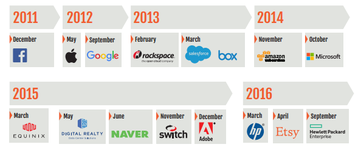In January this year, we launched Stockholm Data Parks together with the City of Stockholm, Invest Stockholm, power grid provider Ellevio and dark fiber provider Stokab. We have a vision – a data center industry where no heat is wasted.
On the march towards making data centers green, laudable initiatives to consolidate data centers, improve energy efficiency, reduce water usage and optimize operations through DCIM are today commonplace. The major companies have also realized that there can be no green data center without renewable electricity, and some of these companies go all the way by adding additional capacity to the renewable system to ensure that their green electricity consumption is not simply pushing the brown electricity to someone else.
The recent Clicking Clean report from Greenpeace is encouraging. In 2015 and 2016, eight major companies made commitments to become 100% renewable. In total 16 companies have now made such commitments.
We are still wasting heat
All these efforts make real progress towards green computing. But there is still a disturbing fact – all the electricity going into the servers is turned into heat that could be reused for residential heating, but is instead wasted by letting it go into the ambient environment.
Imagine a place where the energy is green and excess data center heat wouldn’t be wasted. Imagine Stockholm. For more than 25 years, excess heat from data centers and industrial processes has been captured and reused for residential heating. Today, more than 30 data centers in Stockholm are connected to the city’s district heating and cooling network and involved in heat recovery.
Many attempts have been made in other cities to reuse data center heat. They have, in general, so far not been successful. What makes Stockholm different?
Beyond the extensive experience and a city-wide district heating system already in place, a critical key is the cold climate. Contrary to the general idea that your data center should be in the Nordic countries so that you could reject the heat to the environment, you should be in the Nordic countries because your heat has value in a cold climate. In Stockholm Data Parks, we take care of your excess heat and reuse it, and you get paid.
District heating is needed
A data center produces a lot of heat. In fact, a data center with a load of 10 MW corresponds to the heating needs of around 20 000 modern residential apartments. Thus, the option of extensively reusing heat locally, or in the same building as the data center, is not feasible. You need to be connected to a district heating network to manage large scale heat recovery.
All the electricity going into the servers is turned into heat that could be reused for residential heating, but is instead wasted by letting it go into the ambient environment
Tightly coupled with the challenge to manage the sheer amount of heat is the risk for the data center to rely on a single building or a limited residential area for absorbing data center heat. Only if the data center is connected to a vast network of buildings can heat recovery be performed on a sufficiently large scale and with reasonable risk. With Stockholm’s 12 TWh/year district heating system, there is enough heat demand to accommodate heat recovery from data centers of any size (corresponding to close to 150 data centers with 10 MW load).
Finally, Stockholm has the advantage of having both a vast heating network and the world’s largest cooling network. This allows us to build more flexible, sustainable and cost efficient solutions compared to locations where only a district heating network is present.
Erik Rylander is head of Open District Heating and Stockholm Data Parks at Fortum - Fortum Värme.


